Abstract
Several reports have shown that amino acid utilization via oxidation and gluconeogenesis is increased during exercise. The purpose of this study was to investigate whether these changes are accompanied by alterations in protein synthesis and degradation in the muscle of exercising rats. One group of rats was made in swim for 1h and then protein synthesis and protein degradation were measured in a perfused hemicorpus preparation. Protein synthesis was decreased and protein degradation was increased in exercised rats compared with sedentary control rats. Exercise also decreased amino acid incorporation by isolated polyribosomes from muscle. Measurement of several muscle proteinase activities demonstrated that exercise had no effect on alkaline proteinase or Ca2+-activated proteinase. However, the free (unbound) cathepsin D activity was elevated in muscle of exercised rats, whereas the total activity of catepsin D was unchanged. This increase in the proportion of free cathepsin D activity suggests that lysosomal enzymes may be involved in the increased protein degradation that was observed.
Full text
PDF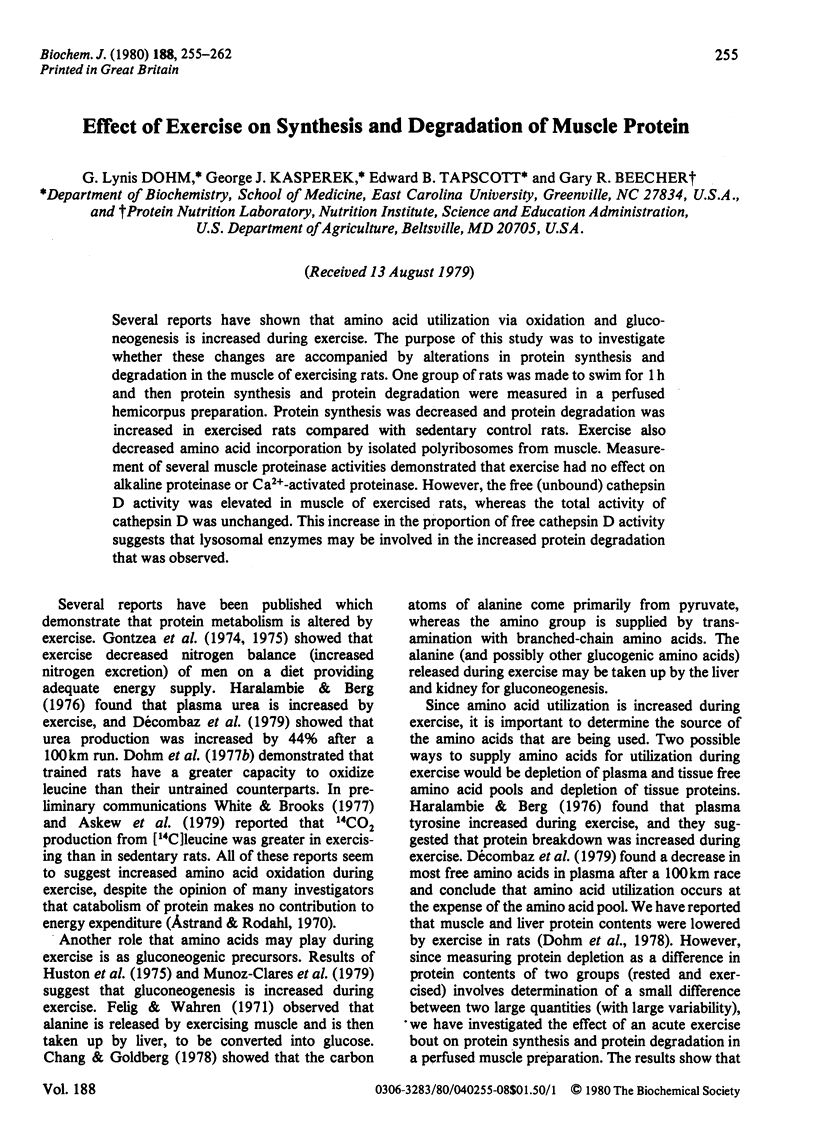
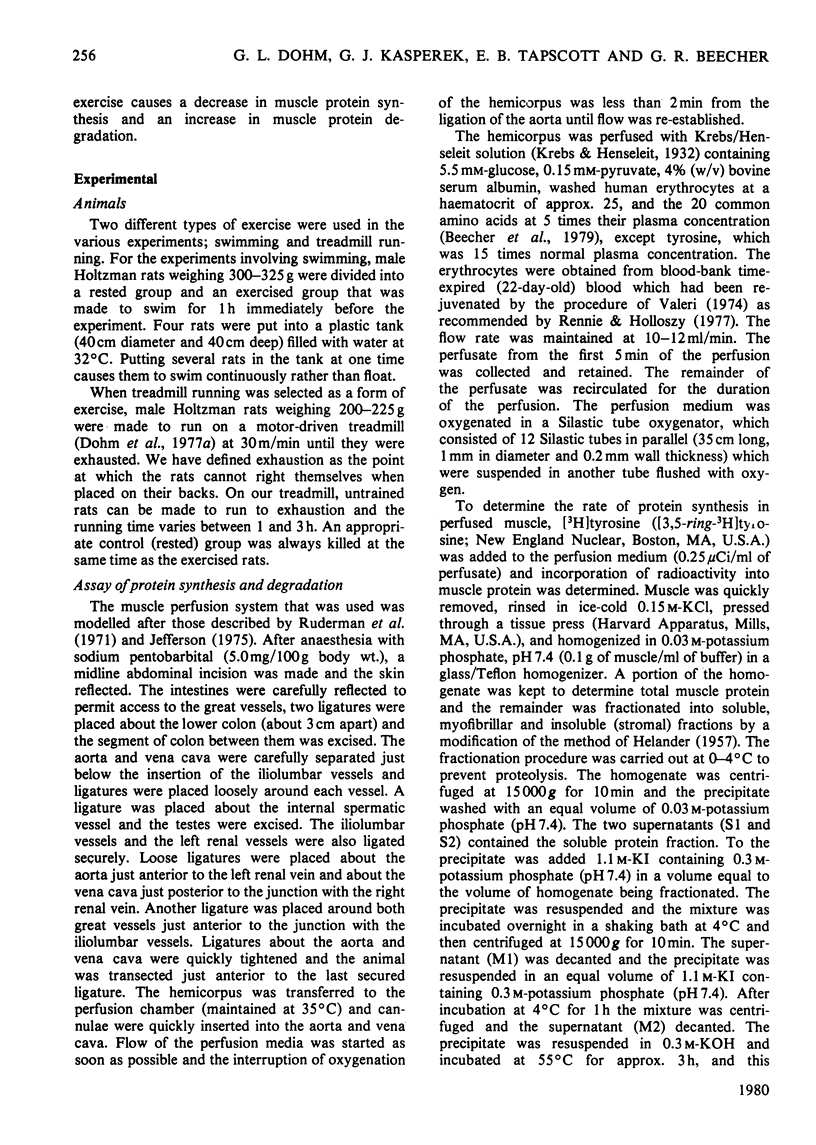
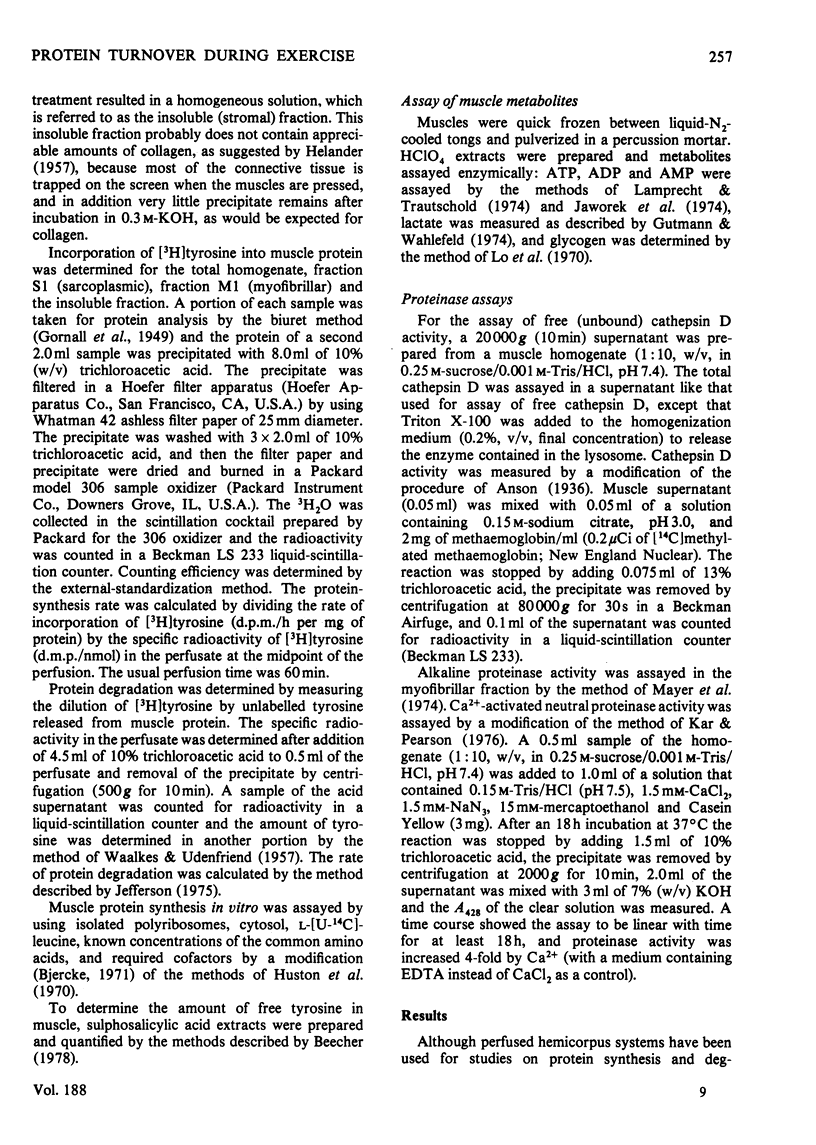
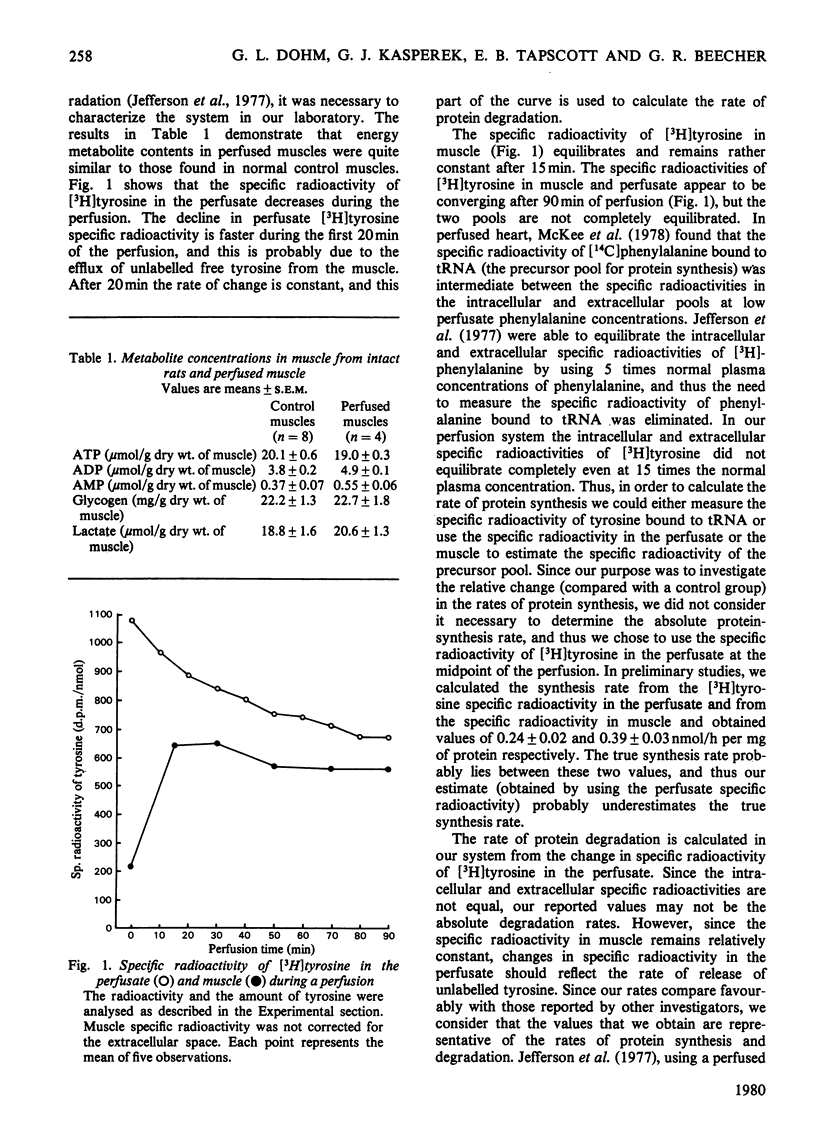
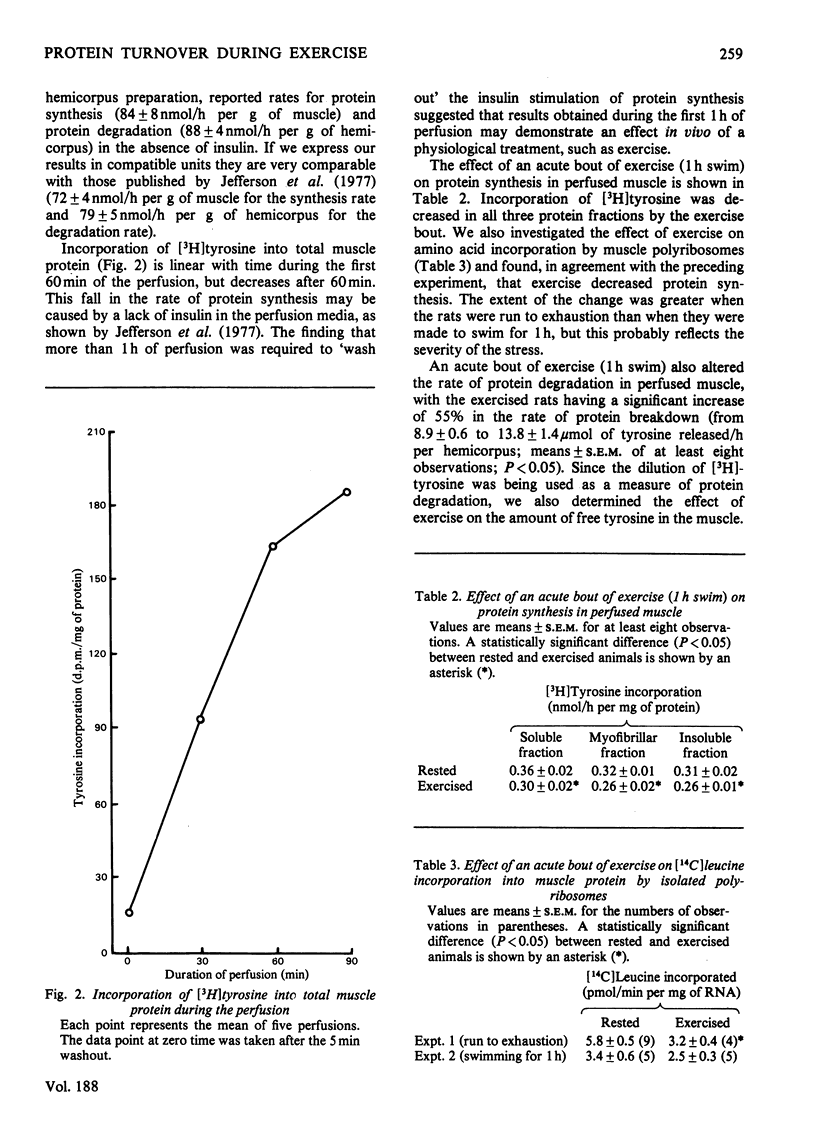
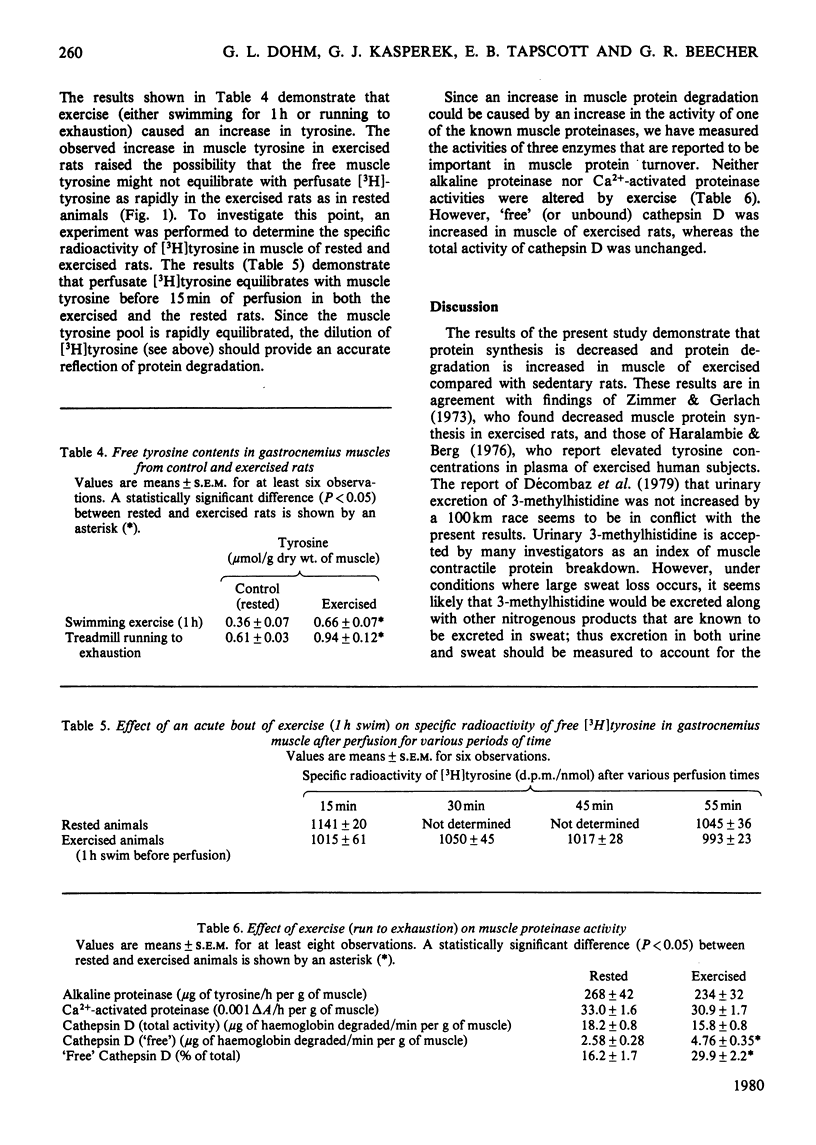
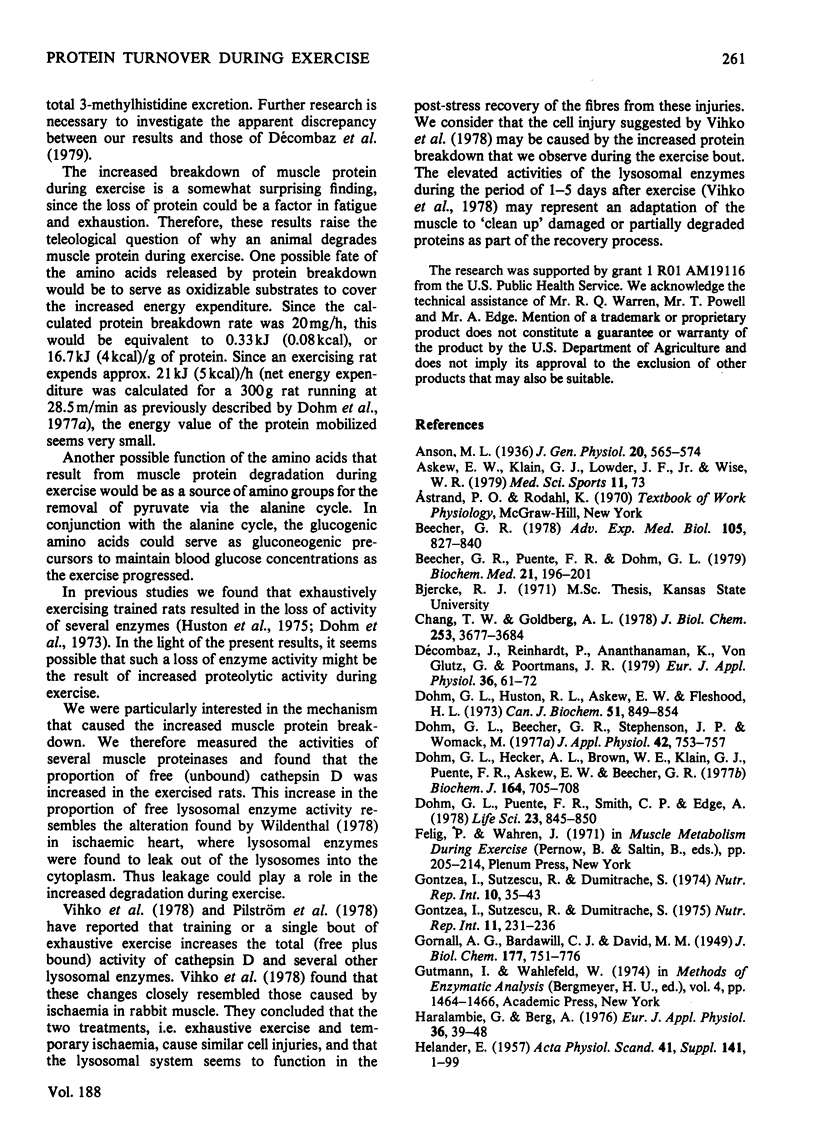
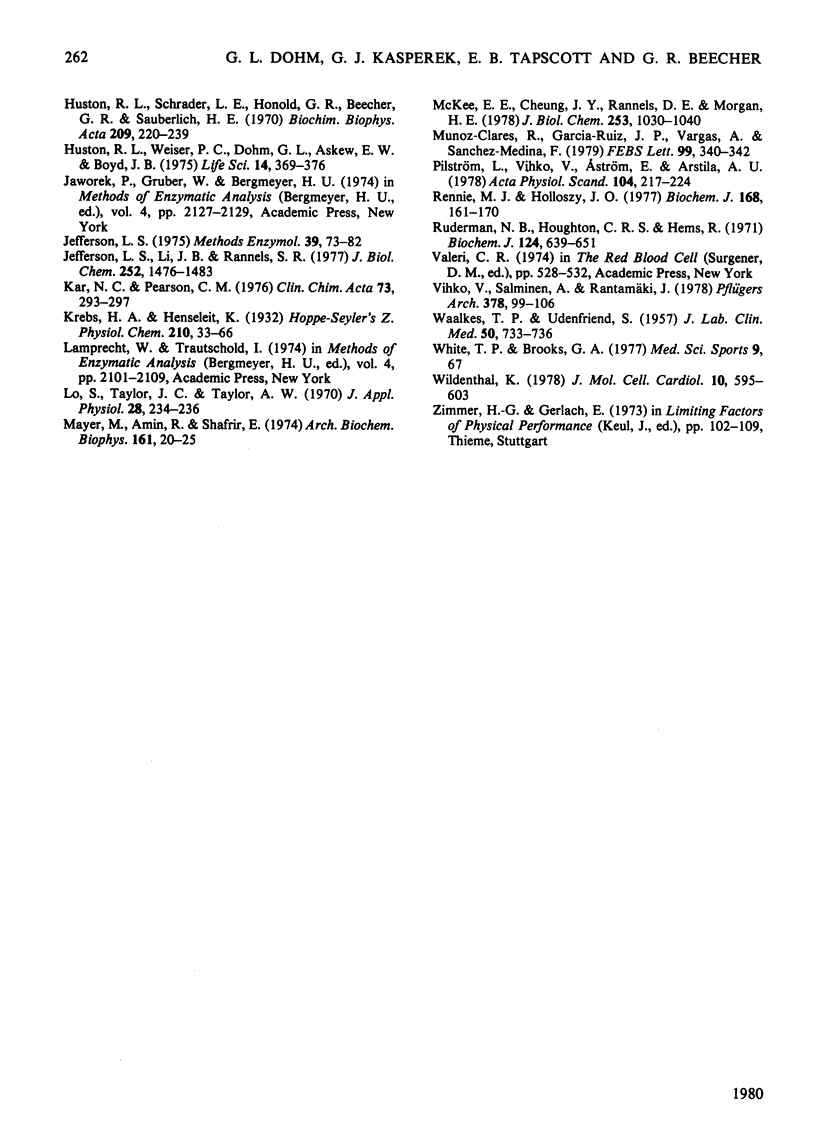
Selected References
These references are in PubMed. This may not be the complete list of references from this article.
- Abstracts of the 1979 American College of Sports Medicine annual meeting and Pan Pacific Conference. May 24-26, 1979, Sheraton-Waikiki Hotel, Honolulu, Hawaii. Med Sci Sports. 1979 Spring;11(1):73–114. [PubMed] [Google Scholar]
- Beecher G. R. Design assembly of an inexpensive, automated microbore amino acid analyzer: separation and quantitation of amino acids in physiological fluids. Adv Exp Med Biol. 1978;105:827–840. doi: 10.1007/978-1-4684-3366-1_39. [DOI] [PubMed] [Google Scholar]
- Beecher G. R., Puente F. R., Dohm G. L. Amino acid uptake and levels: influence of endurance training. Biochem Med. 1979 Apr;21(2):196–120. doi: 10.1016/0006-2944(79)90072-3. [DOI] [PubMed] [Google Scholar]
- Chang T. W., Goldberg A. L. The origin of alanine produced in skeletal muscle. J Biol Chem. 1978 May 25;253(10):3677–3684. [PubMed] [Google Scholar]
- Dohm G. L., Beecher G. R., Stephenson T. P., Womack M. Adaptations to endurance training at three intensities of exercise. J Appl Physiol Respir Environ Exerc Physiol. 1977 May;42(5):753–757. doi: 10.1152/jappl.1977.42.5.753. [DOI] [PubMed] [Google Scholar]
- Dohm G. L., Hecker A. L., Brown W. E., Klain G. J., Puente F. R., Askew E. W., Beecher G. R. Adaptation of protein metabolism to endurance training. Increased amino acid oxidation in response to training. Biochem J. 1977 Jun 15;164(3):705–708. doi: 10.1042/bj1640705. [DOI] [PMC free article] [PubMed] [Google Scholar]
- Dohm G. L., Huston R. L., Askew E. W., Fleshood H. L. Effects of exercise, training, and diet on muscle citric acid cycle enzyme activity. Can J Biochem. 1973 Jun;51(6):849–854. doi: 10.1139/o73-105. [DOI] [PubMed] [Google Scholar]
- Dohm G. L., Puente F. R., Smith C. P., Edge A. Changes in tissue protein levels as a result of endurance exercise. Life Sci. 1978 Aug 28;23(8):845–849. doi: 10.1016/0024-3205(78)90519-2. [DOI] [PubMed] [Google Scholar]
- Décombaz J., Reinhardt P., Anantharaman K., von Glutz G., Poortmans J. R. Biochemical changes in a 100 km run: free amino acids, urea, and creatinine. Eur J Appl Physiol Occup Physiol. 1979 Apr 12;41(1):61–72. doi: 10.1007/BF00424469. [DOI] [PubMed] [Google Scholar]
- Haralambie G., Berg A. Serum urea and amino nitrogen changes with exercise duration. Eur J Appl Physiol Occup Physiol. 1976 Dec 6;36(1):39–48. doi: 10.1007/BF00421632. [DOI] [PubMed] [Google Scholar]
- Huston R. L., Schrader L. E., Honold G. R., Beecher G. R., Cooper W. K., Sauberlich H. E. Factors influencing the isolation of a polyribosomal system from rat liver and its ability to incorporate [14C]amino acids. Biochim Biophys Acta. 1970 May 21;209(1):220–239. doi: 10.1016/0005-2787(70)90678-7. [DOI] [PubMed] [Google Scholar]
- Huston R. L., Weiser P. C., Dohm G. L., Askew E. W., Boyd J. B. Effects of training, exercise and diet on muscle glycolysis and liver gluconeogenesis. Life Sci. 1975 Aug 1;17(3):369–376. doi: 10.1016/0024-3205(75)90486-5. [DOI] [PubMed] [Google Scholar]
- Jefferson L. S. A technique for perfusion of an isolated preparation of rat hemicorpus. Methods Enzymol. 1975;39:73–82. doi: 10.1016/s0076-6879(75)39011-3. [DOI] [PubMed] [Google Scholar]
- Jefferson L. S., Li J. B., Rannels S. R. Regulation by insulin of amino acid release and protein turnover in the perfused rat hemicorpus. J Biol Chem. 1977 Feb 25;252(4):1476–1483. [PubMed] [Google Scholar]
- Kar N. C., Pearson C. M. A calcium-activated neutral protease in normal and dystrophic human muscle. Clin Chim Acta. 1976 Dec 1;73(2):293–297. doi: 10.1016/0009-8981(76)90175-3. [DOI] [PubMed] [Google Scholar]
- Lo S., Russell J. C., Taylor A. W. Determination of glycogen in small tissue samples. J Appl Physiol. 1970 Feb;28(2):234–236. doi: 10.1152/jappl.1970.28.2.234. [DOI] [PubMed] [Google Scholar]
- Mayer M., Khassis S., Shafrir E. Determination of trypsin by its accelerating effect on the onset of trypsinogen activation. Anal Biochem. 1974 Mar;58(1):25–29. doi: 10.1016/0003-2697(74)90436-9. [DOI] [PubMed] [Google Scholar]
- McKee E. E., Cheung J. Y., Rannels D. E., Morgan H. E. Measurement of the rate of protein synthesis and compartmentation of heart phenylalanine. J Biol Chem. 1978 Feb 25;253(4):1030–1040. [PubMed] [Google Scholar]
- Muñoz-Clares R., García-Ruiz J. P., Vargas A., Sánchez-Medina F. Effect of short-term exercise on the content of gluconeogenic metabolites in rat liver and kidney. FEBS Lett. 1979 Mar 15;99(2):340–342. doi: 10.1016/0014-5793(79)80987-4. [DOI] [PubMed] [Google Scholar]
- Pilström L., Vihko V., Aström E., Arstila A. U. Activity of acid hydrolases in skeletal muscle of untrained, trained and detrained mice of different ages. Acta Physiol Scand. 1978 Oct;104(2):217–224. doi: 10.1111/j.1748-1716.1978.tb06269.x. [DOI] [PubMed] [Google Scholar]
- Rennie M. J., Holloszy J. O. Inhibition of glucose uptake and glycogenolysis by availability of oleate in well-oxygenated perfused skeletal muscle. Biochem J. 1977 Nov 15;168(2):161–170. doi: 10.1042/bj1680161. [DOI] [PMC free article] [PubMed] [Google Scholar]
- Ruderman N. B., Houghton C. R., Hems R. Evaluation of the isolated perfused rat hindquarter for the study of muscle metabolism. Biochem J. 1971 Sep;124(3):639–651. doi: 10.1042/bj1240639. [DOI] [PMC free article] [PubMed] [Google Scholar]
- Vihko V., Salminen A., Rantamäki J. Acid hydrolase activity in red and white skeletal muscle of mice during a two-week period following exhausting exercise. Pflugers Arch. 1978 Dec 28;378(2):99–106. doi: 10.1007/BF00584441. [DOI] [PubMed] [Google Scholar]
- WAALKES T. P., UDENFRIEND S. A fluorometric method for the estimation of tyrosine in plasma and tissues. J Lab Clin Med. 1957 Nov;50(5):733–736. [PubMed] [Google Scholar]
- Wildenthal K. Lysosomal alterations in ischemic myocardium: result or cause of myocellular damage? J Mol Cell Cardiol. 1978 Jul;10(7):595–603. doi: 10.1016/s0022-2828(78)80001-7. [DOI] [PubMed] [Google Scholar]


